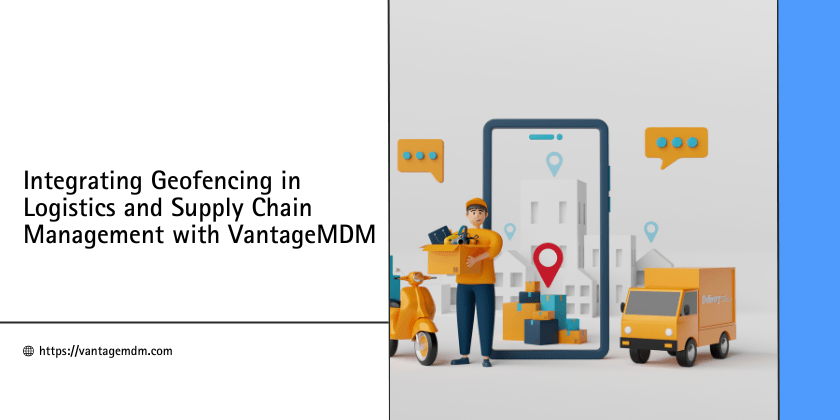Integrating Geofencing in Logistics and Supply Chain Management with MDM

Geofencing software serves as a crucial technology for creating virtual boundaries around specific geographic locations, enabling logistics and supply chain management (SCM) operations to monitor and manage the movements of goods with unprecedented precision. This technology utilizes GPS or RFID to define spatial boundaries, allowing businesses to set up triggers that automatically notify managers when a vehicle or asset enters or leaves a designated area. Such capabilities are instrumental in optimizing route planning, ensuring timely deliveries, and even in automating entry and exit logs for better compliance and security management. By integrating geofencing with Mobile Device Management (MDM) systems, companies gain a robust framework for enhancing real-time decision-making and operational visibility, which is essential in a fast-paced logistics environment.
Further, the use of MDM strategies enhances the utility of geofencing by ensuring that all mobile devices within the logistics network are aligned with the company’s operational goals and security protocols. MDM solutions allow for the centralized management of these devices, ensuring they are equipped with necessary updates and are restricted from unauthorized use, thereby minimizing security risks. The integration of kiosk software further leverages this setup by restricting device functionalities to essential applications based on the user's location and role within the geofenced area. This ensures that employees have access to the tools and information needed for their specific tasks, while preventing access to non-essential functions that could distract from work duties or compromise data security. This symbiotic relationship between geofencing, MDM, and kiosk software creates a controlled, efficient, and secure environment that is vital for modern logistics operations, driving significant improvements in operational efficiency and security.
Understanding Geofencing Software in Logistics
Geofencing software utilizes GPS or RFID technology to create a virtual boundary around a geographical location. This boundary can be dynamically adjusted according to the needs of the business. In logistics, this technology is crucial for automating and refining processes such as inventory management, asset tracking, and on-time delivery.
- Asset Management and Security: By integrating geofencing software with mobile device management systems, companies can automatically monitor entry and exit of vehicles and goods in designated zones. This not only helps in tracking but also in securing assets by alerting managers to unauthorized movements.
- Enhanced Delivery Management: Geofencing allows companies to optimize delivery routes and times, reducing fuel consumption and ensuring faster delivery times. Drivers can be notified of changes in delivery schedules or routes in real-time, leading to more adaptive operations.
- Compliance and Reporting: Geofencing helps ensure that transportation of goods complies with regional regulations. Automated reports generated through geofencing software can be used for auditing and compliance purposes, providing transparency and accountability in operations.
Role of Mobile Device Management in Enhancing Geofencing Capabilities
Mobile device management (MDM) plays a vital role in the effective deployment of geofencing software. MDM solutions help businesses manage and secure mobile devices used in the logistics and supply chain operations, especially when these devices are used in field operations.
- Device Tracking and Management: MDM solutions ensure that all mobile devices are tracked and managed efficiently. This is crucial in logistics, where timely information and communication are key to operational success.
- Security Enhancements: MDM solutions enhance security by enabling businesses to remotely control and lock down Android tablets for business, ensuring that devices are used strictly for business purposes and reducing the risk of data breaches.
- Application Management: Through MDM, businesses can control which applications are installed on a device. This is particularly useful for installing and managing kiosk software, which can guide the users of the device within the logistics network, providing them with necessary information and tools while restricting access to non-essential applications.
Integrating Geofencing with Kiosk Software in Logistics
Integrating kiosk software in devices within a geofenced area can significantly enhance operational efficiency. Kiosk software can be used to lock down the device to specific applications, making it easier for logistics companies to provide their staff with access to necessary tools without the risk of distraction or misuse.
- Targeted Information Delivery: Kiosk software can display specific information related to the geofenced area, improving the decision-making process for drivers and staff on the ground.
- Enhanced User Interface: By using kiosk software, businesses can create a user-friendly interface on devices that staff find intuitive and easy to use, which is particularly important in high-stress environments like logistics and supply chain management.
The integration of geofencing software with mobile device management systems is revolutionizing logistics and supply chain management. By harnessing the power of these technologies, businesses can achieve greater control, enhance security, improve compliance, and ultimately increase efficiency. As technology evolves, the potential applications of geofencing in logistics will undoubtedly expand, further enhancing the capabilities of supply chain management in the digital age.
By focusing on advanced MDM strategies and integrating with technologies like geofencing software and kiosk solutions, logistics operations can not only meet the current demands but also scale for future growth and challenges.